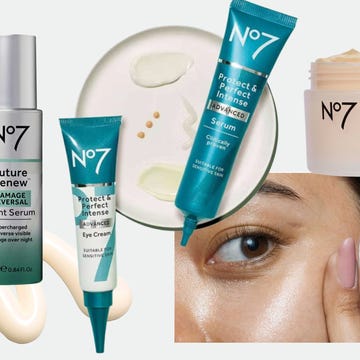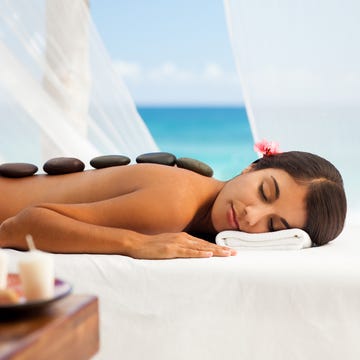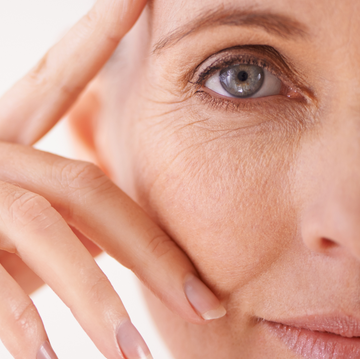‘Oh, my God, did you know your face is bright red? Why is it like that?’ If you’ve ever been tempted to say this to someone, I’ve got some stern words for you. Firstly, of course they know. And secondly, how would you feel if they turned around and said, ‘Did you know your kitchen really needs a clean/those jeans haven’t been in fashion since 2008?’
You’d be rightly outraged. However, when it comes to skin, people seem to think it’s completely fine to offer unsolicited comments, and I’ve heard it all about my rosacea. From the classic ‘Have you been drinking?’ and ‘Are you sunburnt?’ to the accusatory ‘You must be lying’ and the downright unpleasant ‘What’s wrong with you?’ – the tactless comments are endless.
Despite being a condition affecting approximately 5% of the global population, there’s still a lot of ignorance around rosacea – and from GPs to the general public, it can be tough to navigate.
What to read next
If you’ve never suffered from a skin condition, it’s easy to think it’s a trivial issue, but before I was successfully treated, my rosacea impacted every aspect of my life.
As a journalist, I’d turn down opportunities that involved public speaking or being on camera because I was terrified of going red. I’d avoid energetic exercise as it would take hours for my face to calm down, and I’d panic about going red on dates (I used to hide a concealer in the downstairs loo at one boyfriend’s house so I could constantly reapply it). Once, I even tried to back out of being a bridesmaid for fear that I’d ‘ruin’ the wedding pictures.
My last-straw moment
I struggled on, as my confidence was eroded by redness and rudeness. Then, in 2018, came the holiday to Greece, which was ruined by painful lumps erupting on my face and non-stop burning across my cheeks and chin. While my friends went to the beach, I had to hide away in the room and avoid the sun because SPF made my skin feel like it was on fire.
Back home, I visited not one but two GPs. One barely looked at my face, said it was probably dermatitis and sent me away with hydrocortisone cream. The second told me to buy an acne face wash.
Unconvinced, I booked (at great expense – I’m talking the cost of a five-star minibreak) to see a private dermatologist. Within minutes, I had my answer: papulopustular rosacea. This is the form that comes with both redness and bumps/spots, meaning it’s often misdiagnosed as acne.
Getting the right treatment for me
The dermatologist placed me on a course of antibiotics and prescription creams. She also recommended a temporary but complete skincare and makeup detox, stripping back my routine to a foundation for skin healing (Oxygenetix Oxygenating foundation), a simple moisturiser (La Roche-Posay Toleraine Sensitive Fluide) and a gentle face cleanser (Avène Tolérance Extremely Gentle Cleanser).
Within two weeks, my bumps lessened. Six weeks and they’d disappeared altogether, and the redness was also calming down dramatically. Seeing a difference so quickly felt miraculous. I’ll never forget the first time I left the house makeup-free; it was only a trip to the shop, but it had been years since I’d felt able to show the world my face without layers of foundation.
Keeping my rosacea under control
There’s no ‘cure’ for rosacea – rather, it’s all about managing the symptoms. Today, I still have the original prescription products in my arsenal, but sorting the skincare and medication was only the start of the journey.
I tell other rosacea sufferers that it’s just as important to identify your triggers. I recommend keeping a diary on your phone of what you were doing, how you felt and what you ate or drank every time you experience symptoms. Commonly, spicy foods, alcohol (especially wine), hot baths and emotional stress can all contribute to a flare, but you’ll find your own specific triggers, too.
For me, it’s airplane travel, sex and tiredness (not necessarily in that order), on top of red wine, hot drinks and anything with chilli. That’s not to say these have to be avoided completely. I like to do a little ‘rosacea maths’ to decide if it’s worth a potential flare. So: cheap pub plonk on a Friday after work, probably not. A delicious glass of Cab Sauv with a fancy steak dinner, probably yes.
My final piece of advice is to own the redness. Tell your friends, family and colleagues you have rosacea, and that sometimes it might make you look red, spotty or blotchy. For me, posting a makeup-free photo of a bad flare on social media was the moment I felt the hold my redness had over me fade. I wasn’t trying to hide it anymore. If I went red during a work presentation or party, everyone would know why and I wouldn’t feel ashamed.
Seven years on, I’ve never had a flare-up as bad as at my initial diagnosis. I’ve learned that the less I stress, the less likely a flare will appear – and that’s done as much for me and my confidence as thousands of pounds of skincare.
How to get a diagnosis
As a rosacea veteran, people often ask me how and where to seek a diagnosis. I’m sorry to say it can be tricky to get the right support without paying for it. With NHS waiting lists climbing, research recently found an average 43-week wait for a non-urgent dermatology referral.
However, private care has become a lot more accessible over the past few years with the advent of digital dermatology services. High street pharmacies such as Boots, Lloyds and Superdrug offer online services where you can submit photographs of your skin and receive prescription treatment. As I enter my mid 40s and perimenopause and want to build anti-ageing into my routine without my face kicking off again, I’ve come to rely on dermatologist-led prescription skincare services such as Klira and Renew+Me.
My rosacea SOS kit
Jo shares the products that have worked best for her






















